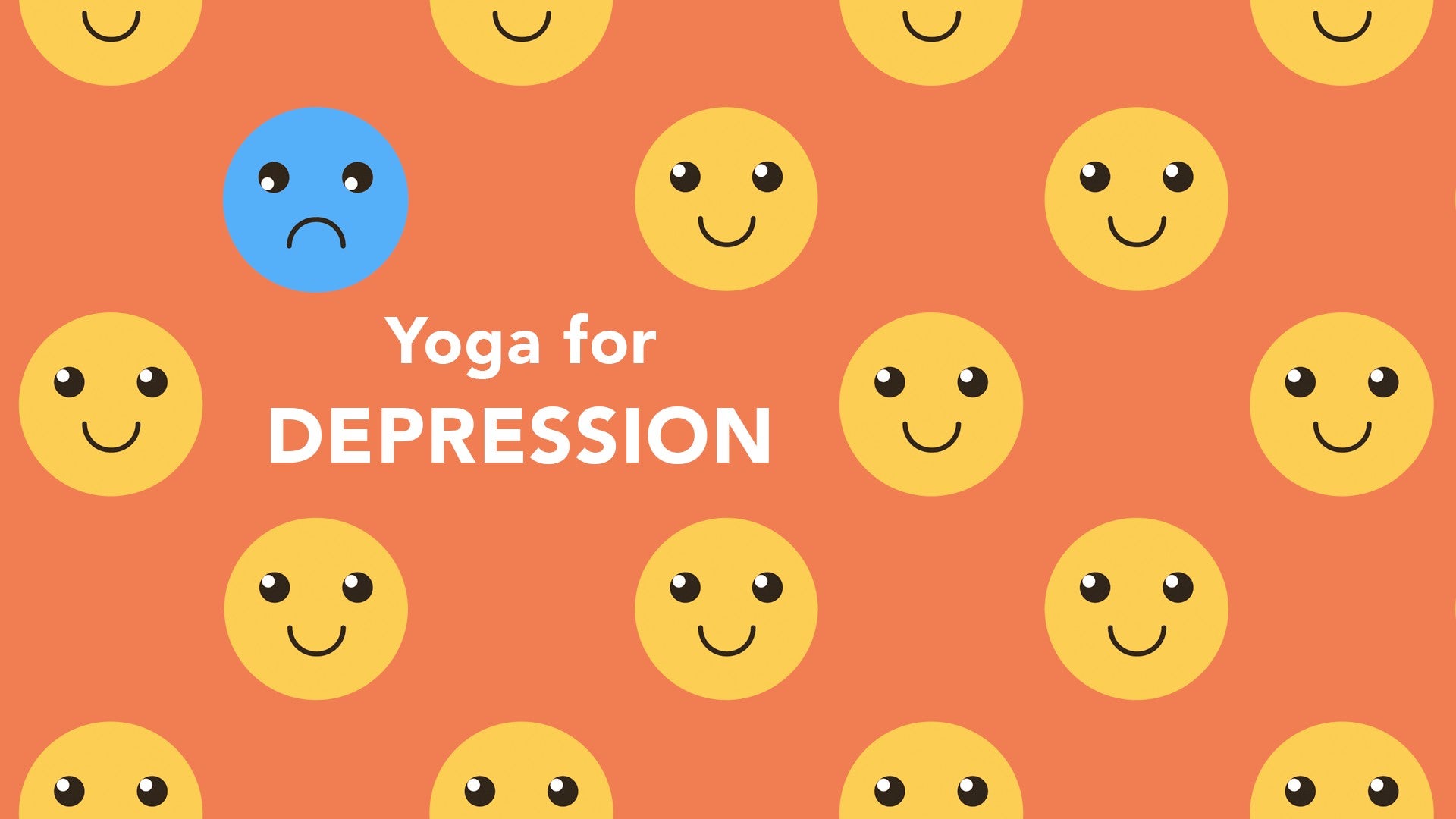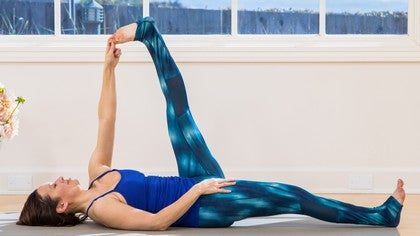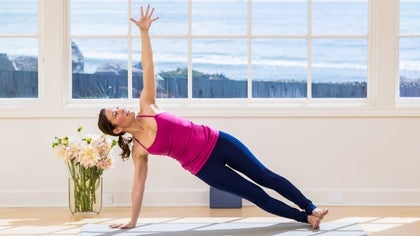Description
About This Video
Transcript
Read Full Transcript
Welcome. We all have times in our lives that are challenging and there's some days where we might not have the energy to do a full practice. Sometimes we need to rest and be a little more restorative. So, I've put together a practice of three poses centered around yoga for grief, which helps us to process and to come into a more healing space when we're dealing with difficult situations. So you'll need a few props for this practice.
I encourage you to have a bolster or pillows that you can use to prop yourself up on. Some blocks are helpful and a couple of blankets, although you can make use of the props that you have at home, so you are comfortable with setting up with the things that you have. If you have a bolster, bring it around. It can be nice to prop bolster up on a block so you have a bit more height. If you know that you have any sensitivity in your knees, it might also be nice to place a blanket underneath your knees, knowing that you'll be here for anywhere from five to 10 minutes.
Join your toes together, take the knees a little wider so that they come around the bolster. Then, breathe in deeply finding some length through your spine, and as you exhale, fold forward, coming to lie down on your bolster. You want to make sure that you're comfortable, filling up the space between your body and the props, giving you the opportunity to allow your arms to go limp, and the props to support you and hold you up. Once you find yourself settled in here, close your eyes, and draw your awareness to your breath. Inhale, take your breath into your belly.
Exhale, release. Inhale breath into the belly and see if you can find some space in your low back. And exhale, allow yourself to sink a little heavier into the bolster. Breathe in, fill the belly, fill your chest. And exhale, empty out your chest and let the belly be soft.
Breath in, feel the belly, feel the chest, feel the back ribs open and expand. And exhale, empty out the chest and empty out your belly. In your next breath, take the breath into the belly. Breath up into the chest, and take it all the way up into the shoulders, and then open your mouth to release. Filling the back body with breath.
Low back expanding, mid-back expanding, shoulders expanding. And exhale. Soften. Allow yourself the chance to feel supported. With little to no sensation, no effort to hold yourself up.
Allowing yourself to be in the pose, rather than doing the pose. Can you let the pose be of benefit to you? As you breathe, perhaps conjuring up a memory of a time when you felt supported and remembering what that was like. Knowing and sensing that it wasn't just you, but that we're all the same and that you're not alone. If you're struggling with coming up with a memory, perhaps creating one now.
How do you like to be supported? What does that feel like in your body? If you have your head turned to one side, turn it to the other side now. Sensing the ground underneath you, as it holds you up, the Earth and the props supporting you. Sensing how you are connected to every other person on the planet.
How we all face difficult moments that challenge us, that make us stronger. See if you can find breath and space using the breath as an anchor, and coming back to it anytime that you notice you've wandered off. Knowing that in this moment, you have everything that you need. Slowly, with as little movement as possible, turn your hands down and start to walk them in as you roll your way up with your head coming up last. For our second pose, we'll use the bolster.
Perhaps prop it up just a touch higher, with one block at its highest height, and the other at its lowest with the bolster across. We'll take a hold of the blanket that you have underneath you, open it out once more, to create a long roll that will go over your feet and underneath your thighs as you draw your feet together and open the knees out to the sides. We'll take a hold of our second blanket, open that up into a long rectangle and then use that across your chest. Arms come underneath, and then we tuck the edges in to hold the arms in place as the palms come to rest to the tops of your thighs and lie your head back. Here observe your breath.
Inhaling and exhaling. Sensing the breath as it enters your body, and then noticing where you feel the breath exit your body. Breathing in a sense of healing, and breathing out any suffering. Inhaling and feeling the oxygen feed every single one of your cells. And exhaling, letting the up breath carry all the things that you don't need.
Allow your breath to feed your spirit, to nourish your soul, and give yourself permission to be exactly where you are without any effort, simply being. If sensations start to arise, notice what they are. Just as you watch your breath come and go, watch the sensations come and go. Sense them as they start to rise. Experience and feel them, but then let them pass, just like the breath.
And when emotions began to surface, watch them come, allow yourself to feel and experience them. See if with the breath, you can let them pass. Using your breathe as an anchor, to ground you in the here and now. Knowing that, we don't control the things that happen in our lives, and we don't control the thoughts we have. But we do control what we do in response to the events that occur, and we choose what we focus on, we choose what we believe in.
Give yourself permission to feel what you feel and notice the tendency to want to cling, to stay in that feeling, perhaps even tell ourselves a story about it. Sense what might be possible if we breathe some space around it. What might it look like? What might it feel like to allow emotions to course through you and then set them free? Sense the possibilities.
Might there be a freedom that could come from letting go? And what might that be like? What might that look like? If there's any resistance that starts to surface, notice that. And imagine holding the tender spots with compassion, sending healing and light wherever they're needed, knowing you have dealt with every challenge that has ever come your way.
That those challenges make us stronger in ways that sometimes we didn't know we needed to be. Breathe, allow yourself to feel, and allow yourself to let go. If this feels like where your body needs to be, and you want to linger here, feel free to do so. Whenever you're ready to come out, slowly use your hands to draw your knees back together and roll to one side. Use your arms to make your way up.
We'll take the props into a version of side-lying Savasana. The bolster will come down by your knees, and we'll roll up the blankets so you're creating a pillow with one of the blankets for your head to rest on, and then another for your arm to rest on. As you bring your hip down onto the mat, bolster supporting the top leg, knee, and shin, and the bottom arm reaching out away from you, as we support the head and the neck, finding something that feels comfortable, so that the neck is concave, and then placing the other blanket underneath the top arm. Allowing yourself to drop into stillness. Allowing yourself to be supported in a way that isn't quite so vulnerable, where you're not feeling fully exposed, nurturing the tender spots.
Finding the places where you can breathe space into your body. Knowing that whatever emotions you feel right now, whatever circumstances you face, they are temporary. They might not feel temporary, but just as the breath comes and goes, feelings and circumstances change. We can use our sensations, we can use our breath to live in the present, freeing ourselves up from the things that have happened, or the things that we worry will happen. Listening to your body, staying here as long as you like, as long as you need to.
Whenever you are ready to make your way up, using your arms and hands to slowly come out, and setting your props off to the side, having a seat and noticing any changes from when we started, feeling grateful that you took the time to find some space for yourself, to connect with your breath, and be in the present moment, knowing that this is healing, that your not alone with this, and that this too shall pass. Bring our hands together and bow to each other with namastae.
Yoga for Depression: Denise Antonini
Comments
It felt quite nice, sticking with the emotions and letting them out rather than bottling them up.
I wonder if YogaAnytime would possibly make a series about Yoga for Grief. I would definitely watch it and incorporate it into my practice.
http://www.yogaanytime.com/show-se ason/4533/Yoga-Therapeutic-Yoga-Sea son-2-Stress-Anxiety-and-Grief
With Affection, Kira
Love & light,
Denise
https://www.yogaanytime.com/show-season/4533/Yoga-Therapeutic-Yoga-Season-2-Yoga-for-Stress-Anxiety-and-Grief
You need to be a subscriber to post a comment.
Please Log In or Create an Account to start your free trial.

















